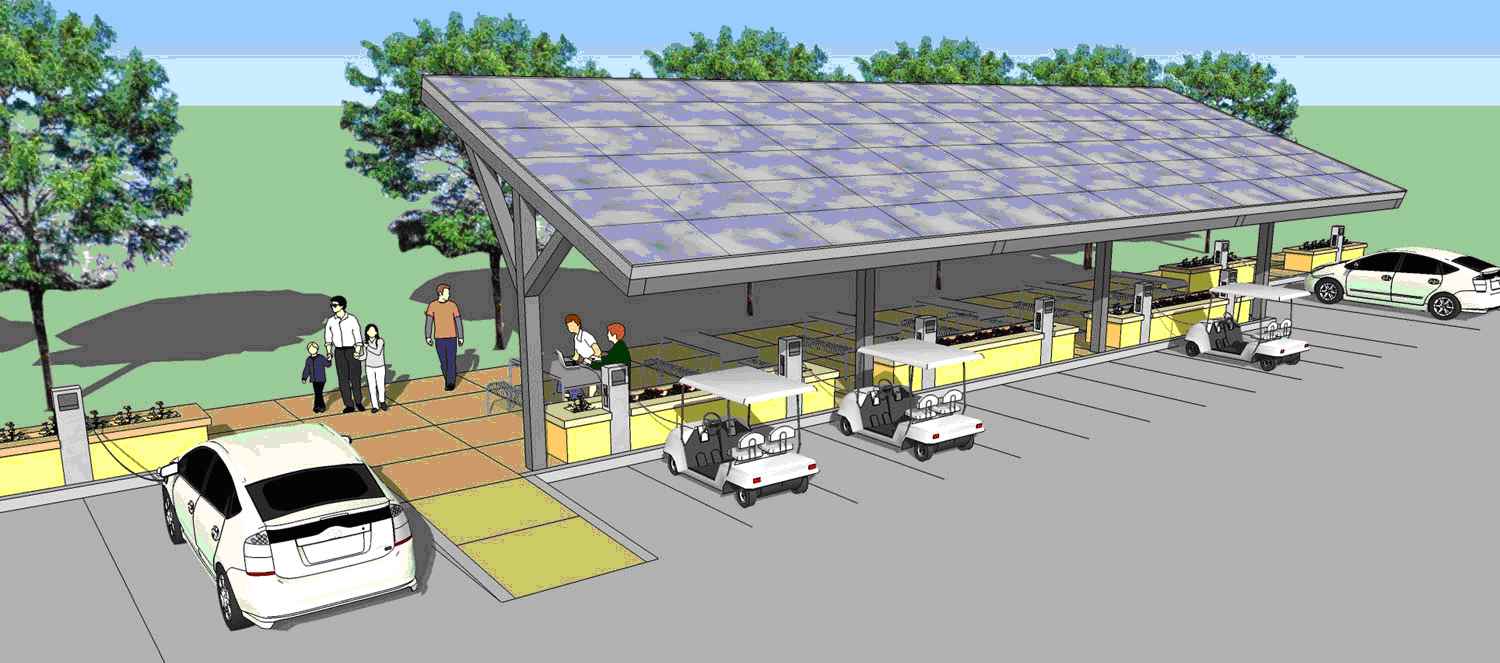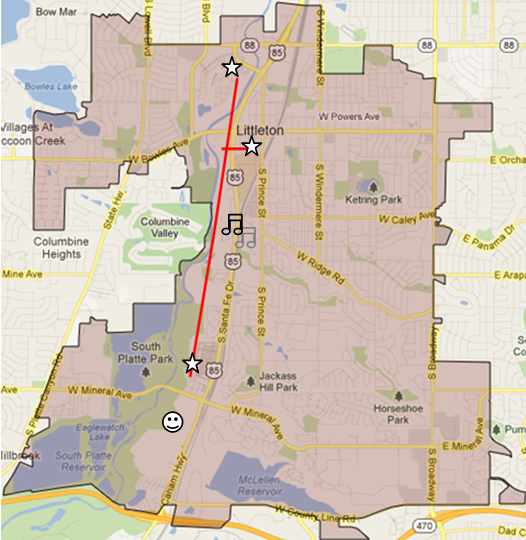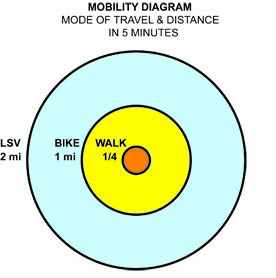LSV (Low Speed Vehicles) for Personal Transporation
Author: HLP
Scorecard Categories Addressed
- Cost of Living
- Transportation
- Resources
Solution Description
Promote LSV use for local travel.
To support this, the city should do a
"connectivity analysis". The connectivty analysis
will identify where people live and locations that they
would want to frequent such as parks, grocery stores,
schools, places of worship, and work locations. Next,
identify roads with speed limits <= 35 MPH (some states have
different limits, see the link below).
Note: Publishing this map would help LSV users.
If the key destinations are not easily reached,
see if there is an easy way to add the missing connectivity
such as changing a speed limit from 45 to 35 mph for a small
section of the road.
Ideally, to help reduce range anxiety, charging
stations could be set up around town. The following
conceptual drawing shows 6 car parking spots being converted
to 12 LSV parking spots in addition to some new tables. Solar
panels provide the electricity for the vehicle charging.




http://www.polaris.com/en-us/gem-electric-car/passenger-vehicle/e2/pages/overview.aspx
($7800)
Stakeholder Impact
All People
Lower emissions
Lower noise
Families with Kids
Lower cost for local transportation. The most cost
effective solution would be for the family to be able to
replace a second car with an LSV. This will only work if
two cars are not simultaneously needed for regional travel.
For better or worse, many families will buy a car for a new
teen driver. LSVs would provide a lower cost option that is also
safer for the new driver (max speed is 25 MPH), while still
allowing the teen a new mobility option.
Seniors
When the senior needs to hang up their car keys, they should
still be able to safely drive the lower speed LSV.
The cost to own and operator an LSV is less than a car and
should help when in a fixed income situation.
City
LSVs are 1/4 the size of a full size vehicle. Once enough
LSVs are in use, this will allow the city to increase their
parking by converting some car parking to LSV parking.
The city
could also reclaim some of the parking for other uses such
as street side seating for a restaurant. This could lead to
additional sales tax income for the city.
Developers
With the reduced parking needs for LSVs, the building footprint
can be increased, thereby increasing profits.
Case Study
Augusta Greenway Association:
Group in Augusta Georgia with one of their goals being to
promote LSV use.
http://augustagreenway.org/wordpress/?page_id=167
AARP Report:
This is an excellent report that includes:
- Defintions of LSVs
- Comparision of LSVs to golf carts and cars
- Example LSVs
- Safety Considerations
- Case Studies:
- The Villages, Florida: Age-Restricted Retirement
Community, "50,000 golf carts zip along its trails and streets ... residents
make more than three-fourths of their
daily trips within the community, largely
because of its extensive accessibility for
golf carts and LSVs."
- Peachtree City, Georgia: "many of Peachtree
Cityís roughly 34,000 residents (about
13,600 households) use golf carts.
More than 10,000 golf carts are
registered within the city ... Many students at
McIntosh High School drive their golf
carts to school ...
Several businesses have
created designated golf cart parking
spaces in front of their stores"
- Western Riverside Council of Governments,
California: Diagrams
for how LSVs integrated into the road system
- Linton, Indiana: "helped the city
build upon themes established in its
recently adopted comprehensive plan: 'a
good place to grow up and a good place
to grow old.' It also complemented other
age-friendly community work."
- Recommendations
Some quotes from the article:
"Operating costs for LSVs range from one to three cents per
mile, depending on the rate charged by the electrical
company and the time of day the vehicle is recharged. By
comparison, the fuel costs associated with operating a
gas-powered personal automobile (as of 2010) range from
nine to thirteen cents per mile, depending on factors
such as vehicle size and fuel efficiency."
"The National Household Travel Survey
reported nearly 70,000 light electric
vehicles and golf carts in operation on the
nationís roadways in 2009, the first year
the Federal Highway Administration began
tracking this vehicle type. Americans took
more than 180 million trips and drove
nearly 65 million miles on these vehicles
that year. Forty-five percent of these trips
were taken by persons age 65 and older, a
surprisingly high number given that older
adults comprise just 13 percent of the U.S.
population and account for 12 percent of
all trips in the United States."
"More than three-quarters (76%) of all
American vehicle trips are 10 miles or less.
The use of LSVs for a larger
share of these short trips could play an
important part in reducing Americaís
greenhouse gas emissions."
Full Report:
http://assets.aarp.org/rgcenter/ppi/liv-com/insight54.pdf
Littleton, Colorado:
Littleton is a example of city that is a good candidate
for adding an LSV network.

Littleton has 3 shopping and restaurant areas
(star icons)
that are connected by a popular bike and pedestrian trail.
Each shopping area also has residential close by. In the
middle of the trail is an event center (musical note icon)
that hosts concerts in
the summer and other events throughout the year. At the
southern edge of the trail is a large undeveloped property that
is for sale (smiley face icon).
This property has enormous potential for some
combination of residential and retail use and could easily
be tied into the proposed LSV network.
Because the trail is in a greenbelt, there is extra
open space. This space should be enough room to add LSV lanes.
The trail does cross a river in a couple of places, so some
widening of the bridges will be needed.
The area along the river is under developed.
Adding an LSV network in conjunction with development
along the river has potential to dramatically transform
the city and be a large economic generator.
Additional Information
Summary of LSV Rules for Each State:
http://www.iihs.org/laws/lowspeedvehicles.aspx
Federal Rules and Definition for LSVs:
http://www.nhtsa.gov/cars/rules/rulings/lsv/lsv.html
Quotes from:
http://www.sierraclub.org/sierra/200803/twowheeled.asp
"Nearly half of all trips in the United States are three
miles or less; more than a quarter are less than a mile."
"A bicyclist can cover a mile in 4 minutes,
while a pedestrian requires 20."
A LSV traveling at the maximum speed of 25 MPH could can cover a mile
in 2.5 min.

Note: The above 4 min. for 1 mile is 15 MPH. This seems like an advance
bicyclist. The Mobility Diagram assumes a less advance bike rider.







